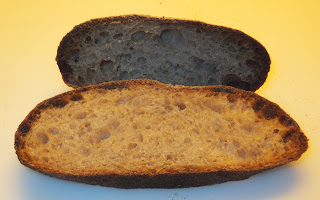 I did manage to successfully rebuild my starter after two a day refreshments for three days in a row. It's now reasonably vigorous for something kept in a refrigerator. The process did leave me with a lot of discarded starter that I refused to dump down the disposal or put in the compost bin. The thought of wasting 200 g of starter didn't sit well with me so I applied the discard to making some bolilos, a type of Mexican enriched roll.
I did manage to successfully rebuild my starter after two a day refreshments for three days in a row. It's now reasonably vigorous for something kept in a refrigerator. The process did leave me with a lot of discarded starter that I refused to dump down the disposal or put in the compost bin. The thought of wasting 200 g of starter didn't sit well with me so I applied the discard to making some bolilos, a type of Mexican enriched roll.The process started by building a large quantity of starter to 70%. I then mixed that with an autolysed dough, followed with olive oil, brown sugar, and salt. Not necessarily authentic but good enough for a raggedy home baker. The four rolls were scaled out to around 215 g or so.
The sesame seeds were on the towel I used for proofing but didn't stick very well. I should have just used an egg white wash and sprinkled the seeds. While I got a decent oven spring, the crumb wasn't very open. The flavor was on the sweet side due to the brown sugar but certainly not offensive. I'm just not someone that goes crazy over rolls. I can appreciate the work involved but my tastes lead me elsewhere.They were a good lesson.
Starter
340 g starter at 70% hydration
Main Dough
300 g bread flour
200 g water at 85F
10 g kosher salt
1 Tbs olive oil
1 Tbs brown sugar
The other two loaves are a 33% whole wheat and a 30% whole wheat with extra bran added. The dough is behaving differently in this summer heat so my answer for the next loaf is lower hydration and perhaps smaller in size. I haven't found a brotform smaller than the oval shaped one I've been using for quite a while so I may be adding a sheet of bakers linen to my inventory. As some wit from days past once said, "the only difference between man and boys is the cost of their toys". I suspect that she has been proven right many times over.
The most unexpected guest dropping in on my blog recently was from the island of Guernsey along with other guests from Sweden. S. Korea, and Romania.
Comments, humor, and questions are welcome.





















